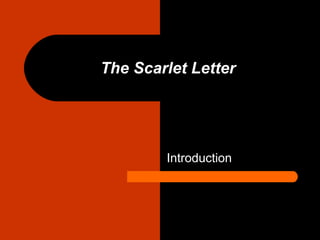
Introduction to the Scarlet Letter
- 1. The Scarlet Letter Introduction
- 2. Nathaniel Hawthorne – the man behind the novel 1804-1864 Sometimes known as an Anti-transcendentalist – didn’t believe in man’s power to go beyond He believed that evil was a dominant force in the world and his fiction expressed a gloomy version of human affairs
- 3. Cont. Inherited Guilt – born in Salem, Massachusetts and was descended from a prominent Puritan family. Ancestor played key role (hanging judge) in Salem witchcraft trials Another ancestor was known for the persecution of Quakers Most of his works deal with inherited guilt
- 4. Hangin’ with the Trancendentalists Lived in a Utopian society (Brook Farm) for a while Got married and moved to Concord Hung out with Emerson and Thoreau (leaders in spiritual philosophies) but didn’t gel with their beliefs
- 5. Out of There Appointed surveyor at Salem Custom House (which accounts for the first part of The Scarlet Letter) This is where he wrote (and grained great success with) The Scarlet Letter. Typical of Hawthorne’s work, this novel deals with guilt and sin among early Puritans.
- 6. The Historical Context of the Novel Hawthorne chose Boston in the 1640s as the setting for the text – only about a 1000 English Puritans lived there then Puritans (established during reign of Queen Elizabeth – thus the reference to her) sought to purify the church and wipe out all traces of Catholicism (thus the negative Catholic comments) Boston was ruled by a theocracy and the government was not intended to provide religious freedom to all Those who didn’t fit in (i.e. Quakers) were dealt with harshly.
- 7. Predestination – a Puritan Doctrine Puritans believed that all things are controlled beforehand by the Hand of God. All humans deserved damnation because of original sin however God elected to save some anyway. One could not influence that destiny by good works or alter the divine plan. Nonetheless, Puritans fought to remain righteous, suppressing the desires of the flesh (which is why what Art and Hester do is sooooo bad). Puritans believed they could recognize internal corruption in others. Harsh discipline wasn’t necessary to punish, since God would do that. It was to show others what would happen if they did the same thing. This is why Hester is pointed out all of the time.
- 8. There were some paradoxes… Although Puritans embraced a strict life, it wasn’t always somber and simple. They encouraged tradesmen and craftsmen to live among them They prized simplicity yet loved fine clothing. Their furniture makers developed great artistry and their leaders (like the governor Hester goes to visit) lived in fine houses.
- 9. Interesting… Although Hester Prynne is fictional, she may have been derived by a woman to whom Hawthorne’s ancestor meted out punishment. Hester Craford, for fornication with John Wedg, as she confessed, was ordered to be severely whipped. The whipping was delayed until six weeks after she gave birth to the illegitimate child.
- 10. The Main Themes of The Scarlet Letter Sin and its effect on the individual Hawthorne explores this by tracing the consequences of different kinds of sin on three different characters: Hester, Dimmesdale, and Chillingsworth The consequence of sin is alienation, and as their sins differ, so do the kinds of alienation that result from them.
- 11. The Basic Plot Involves triangle of husband, wife, and lover Ignores the seduction, the wife’s conflict (prior to sinning), and so on. Focuses on the effects of sin It starts on the scene of Hester’s public humiliation – the first step of her painful redemption.
- 12. The Structure of the Novel Characters interact in relatively few fully developed scenes, much as they were appearing on stage – a very innovated method for 1850. There are a series of dramatic scenes with some expository chapters interspersed – mainly focusing on the main character, Hester.
- 13. The Three Main Scenes All take place on the scaffold They underscore the unity of the novel They bring together the four major characters and show their changing circumstances throughout the novel.
- 14. The Characters Hester Prynne Pearl Roger Chillingsworth Reverend Arthur Dimmesdale
- 15. Symbolism The forest The Scaffold The Names The Scarlet Letter (duh!)
- 16. Works Cited "TeacherWeb - Websites for Teachers, Schools, and Districts." TeacherWeb - Websites for Teachers, Schools, and Districts. “The Scarlet Letter Review, n.d. Web. 5 Oct. 2014. <http://teacherweb.com/>.